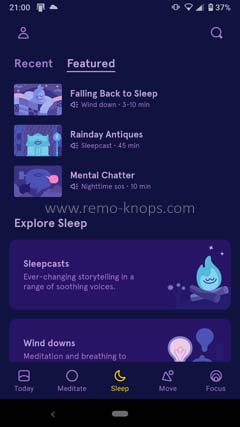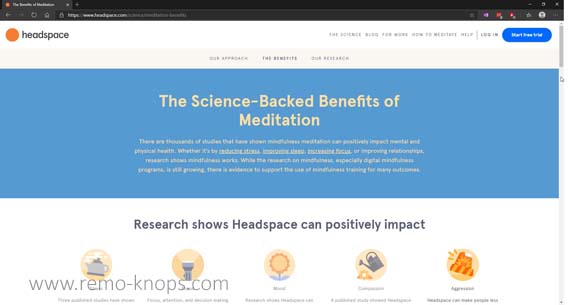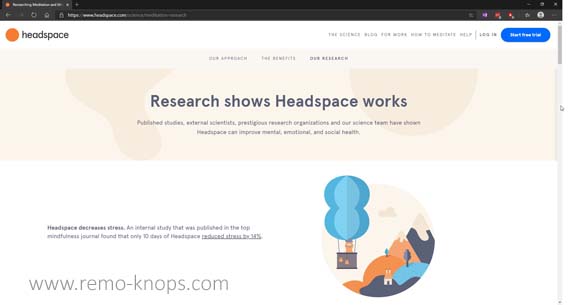In this article I will share my thoughts on the book “The Headspace Guide to Meditation and Mindfulness” by Andy Puddicombe. I also an active user of the headspace service and make the daily investment of 10 minutes a day to meditate.
The Headspace Guide was listed by Bill Gates in the article “5 summer books and other things to do at home” on gatesnotes.com Summer Books for 2020.
TABLE OF CONTENTS
Headspace Guide Book Structure
I know that Bill Gates is a consistent reader of books (check out the Netflix series inside bills brain), so I follow his book reviews. The Headspace Guide was part of the Summer Books for 2020 overview. It is very cool to read the book review from Bill Gates and “Why he is into meditation.” So the founder and former CEO of a global corporation that changed millions of lives through software, is doing a couple meditation sessions per week. So cool !
I purchased the book myself, despite having a daily meditation regime as of April 2020 (one of the results of going through a certified High Performance Habits coaching program). I simply was curious to get more insights, background and understanding about getting a little more Headspace.
| # | CHAPTER DESCRIPTION | PAGE |
|---|---|---|
| 00 | Acknowledgements | v |
| 00 | Introduction | 1 |
| 01 | The Approach | 45 |
| 02 | The Practice | 91 |
| 03 | The Integration | 127 |
| 04 | Practicalities: Getting Started | 199 |
| 05 | Ten Suggestions for living more mindfully | 217 |
| 06 | Tales from the clinic | 225 |
| 10 | Offline diary | 247 |
| 11 | Sources for research Findings | 257 |
The table above provides an overview of the Headspace Guide book structure. The book consists of 3 parts:
- The Approach;
- The Practice;
- The Integration;
Meditation – The Approach
In the approach section Andy Puddicombe describes his own journey but also goes very specific in different areas of the approach to meditation. I loved the story telling aspect where Andy really shares the wisdom of his teachers. This philosophical and conceptual approach to mediation you will get every day by doing the meditation of the day. 🙂
- Meditation and thoughts;
- Meditation and emotions;
- What goes down, must come up;
- Locating emotion;
- Fleeting emotions;
- Headspace and emotions;
- Gentle curiosity;
- What the research shows;
What you don’t see in the bulleted overview above is that the Andy Puddicombe’s personal journey is alternated with practical exercises where you need to put down the book. As the subtitle mentions, the book is just a guide where you build the meditation practice by consistently doing mediation-sessions.
Also note the research aspect that you will also see in a later section of this article: Headspace – Meditation meets Science.
Meditation – The Practice
If you are using the Headspace App than you are probably familiar with the Take10 steps and phases.
- The practice;
- The theatre;
- Take10 – Introduction;
- Take10 – Summary;
- Take10 – Explained;
- What the research shows;
You make sure you get ready for the meditation, than prepare for the focus on your breaths by settling into your surroundings, check-in on your body, scan through it and notice how you are feeling. The main part of the Take10 practice is the focus of your mind on the breaths and its rhythm. The last part is the closure or finishing-off part where you bring back the focus outwards, to the touchpoints of your body and the surroundings. The last finishing off is sort of the reverse of the check-in. 🙂
Meditation – The Integration
In the integration section Andy Puddicombe tells stories about the further integration of mediation and the Take10 practice in different areas in life. As you can see in the section titles below the variety show how the four different mediation postures can get you in a more mindful state.
- The integration;
- Mindfulness in action;
- The dot-to-dot day;
- The distracted man;
- The juggling monk;
- Headspace for eating;
- The five-start monastery;
- Headspace for walking;
- The zombies;
- Headspace for exercise;
- The prostration;
- Headspace for sleep;
- The Russian policemen;
- What the research shows;
The four meditation postures are cross-legged-seated, walking, standing and lying down. Mastering them all will allow you to apply mediation in more areas of your life. Integration is the most interesting section to read when you are already using the Headspace app for some time. There is so much opportunity to become more mindful, and the personal stories of Andy in this section are inspiring and simply stick.
Headspace App for Google Android and Apple
The Headspace App for Android is the most easiest access to the Headspace service. It is a matter of connecting the Sony WH-1000xM3 Bluetooth Headphones with Noise Cancelling to the Nokia 8 Sirocco and launch the Headspace App on Google Android.
The Headspace App has the following menu-pages or menu-tabs, at the bottom of the screen. The breakdown of the structure is listed below:
- Today
- Meditate
- Sleep
- Move
- Focus
On the Today page you will get “the wake up” Headspace video, the list of recent videos and the featured collection.
Meditate Page in Headspace App for Google Android
The Meditate page also shows the recent and featured videos, but also my favorite “today’s meditation” on a specific topic. I perform this today’s meditation almost every day for 10 minutes. When completed you get a quote of wisdom that helps you further deepen the topic of the day. Furthermore you see the heading “explore meditation” that shows you the following categories:
- Courses and singles;
- SOS;
- Timers;
- Techniques and support;
- Politics without Panic;
The amount of different meditation topics and videos is very significant. So the explorer in me is always looking to find new topics or courses. And the final heading is the option to join the group meditation. Basically this is the today’s meditation with fellow Headspace buddies. 🙂
Sleep Page in Headspace App for Google Android
The Sleep page starts again with your recent and featured meditation. Than just like the meditate page you well see a heading “explore sleep” with the following categories:
- Sleep casts
- Wind downs
- Nighttime SOS
- Sleep Music
- Soundscapes
- Sleep radio
Until now I’ve just used the nighttime SOS “racing mind” a couple of times. Which is an excellent exercise to calm down when you can’t sleep well. The trick is to let the mind do some focused action, but not to much.
Move Page in Headspace App for Google Android
Honestly I don’t use the move page in the Headspace app. Simply because I prefer to be outside riding my road bike or hiking through the forest. However it can help you increase your activity with doing workouts through the Headspace App.
Focus Page in Headspace App for Google Android
The Focus page starts again with your recent and featured meditation. Than just like the meditate page you well see a heading “explore focus” with the following categories:
- Focus Music
- Focus Exercises
- Mindful Earth
- Soundscapes
Mindful Earth is the result of a collaboration with BBC Earth and features amazing video footage. However the Focus Music and Focus Exercise categories are the ones I use most.
Headspace on Netflix
The latest option to get some Headspace is a new animated series on Netflix, which is recently in 2021 announced.
“We’ve teamed up with Netflix to bring you a new way to get some Headspace. Headspace Guide to Meditation, our new animated series, narrated by Headspace co-founder Andy Puddicombe.”
By the time of publication there are 8 episodes available to watch via Netflix. Of course you will get the same framework to build your meditation and mindfulness practice as you do through other channels.
While it was fun to watch, I’ll stick to the Headspace app on Android. 🙂
Headspace – Meditation meets Science
The very cool thing is that at headspace meditation and science go hand-in-hand. You can see three pages covering the science area of Headspace:
- Approach
- Benefits
- Science
Science Approach at Headspace
At Headspace we see meditation as both a practice rooted in ancient history and a topic of modern science. This is why we are as equally committed to providing authentic expertise in meditation and also studying the science of meditation. Science has been an integral part of the Headspace business since day one. We recognize that the only way to know if we are achieving our goal of improving the health and happiness of the world is to measure it. […]
You can also see the senior scientific staff, the vast amount of studies conducted and the resulting publications. Finally a there are 35+ scientific partners that are collaborating with the Headspace team.
Benefits from using Headspace
Whether it’s by reducing stress, improving sleep, increasing focus, or improving relationships, research shows mindfulness works. While the research on mindfulness, especially digital mindfulness programs, is still growing, there is evidence to support the use of mindfulness training for many outcomes.
Of course the data gathered from all Headspace users with monthly check-ins on stress, makes us all part of the Headspace research project. But you can also read a lot of information and proven benefits of meditation in the benefits page. You can also read additional information on the benefits per topic (for example stress, focus, mood).
Published Research Examining the Impact of Headspace
The last page consists of a long list of scientific publications on the impact of Headspace. So if you are interested to absorb the science, go get the articles from the scientific journals.
Concluding thoughts and wrap-up
Back in the old days when I actively performed Kung-Fu, meditation was an integral part of sports. Now I’ve turned 40 and found my way to meditation again to keep head and heart aligned. Furthermore I was moved by the sincere conclusion from Bill Gates in his review of the book where he reflects on the benefits now and in his early days at Microsoft.
Mike Ang, my Certified High Performance Coach, pulled me into the 21 Days Abundance Meditation Challenge but gave me the pointer of using Headspace. I’ve created a new (atomic) habit of mediation at least 10 minutes a day. With a small daily time investment the impact on your wellbeing and other parts in your life is significant. It quickly becomes a framework in how to approach the different parts and its dynamics of life.
So Bill Gates gave a good pointer as well to get some Headspace (for at least 3 times a week). The price-point of Headspace Plus is 58,– per year, which for me is very reasonable for the value and benefits it has.
“Less stressed. More resilient. Happier. It all starts with just a few minutes a day.”
Personally I can agree with the benefits. With monthly check-ins and answering about 10 questions you are rated on your stress levels. 😉 Headspace also helps me to focus, since I have a broad spectrum of interests and can be distracted given this drive to learn.
I’m curious if your are open for meditation, and if so which app you are possibly using.

About Andy Puddicombe
Andy Puddicombe is an English author, public speaker and a teacher of meditation and mindfulness. He is the co-founder of Headspace, alongside Richard Pierson, a digital health company that provides guided meditation training and mindfulness for its users.















